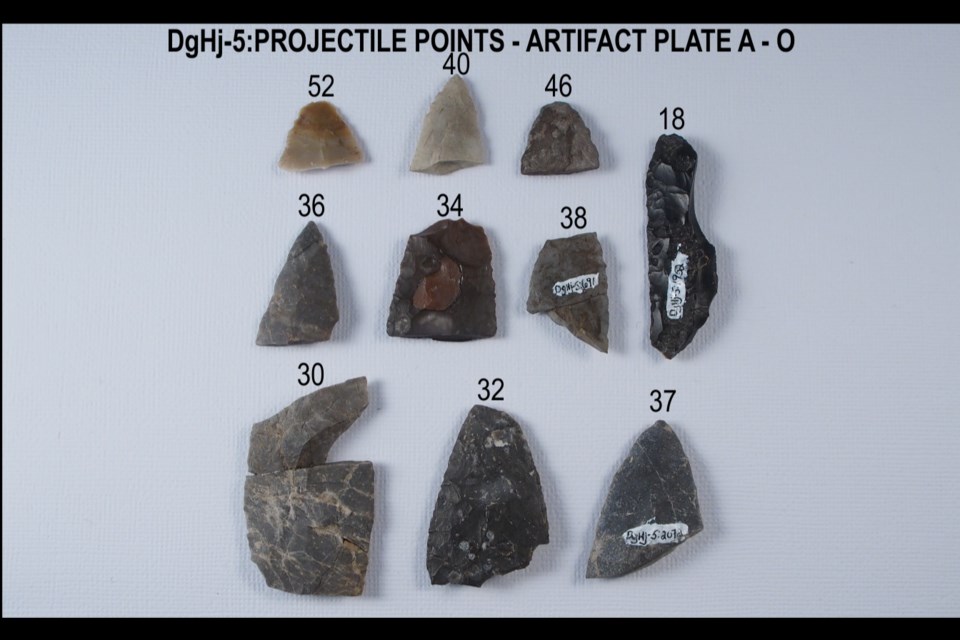More than 11,000 artifacts, some more than 7,000 years old, are going to be transferred to the Timmins Museum: National Exhibition Centre this year.
An agreement was reached between the Timmins museum, Mattagami First Nation and Taykwa Tagamou Nation to store the artifacts from Yellow Falls — located near Smooth Rock Falls— at the museum, according to the city's Indigenous Engagement Framework progress report.
The artifacts are from all time periods, going back as early as the late Paleo-Indian period, which in that area happened about 7,000 or 8,000 years ago, said Ryan Primrose of Woodland Heritage Northeast.
“It’s a very important site and it served to push the history of the area back about 1,000 years. It’s the first information that we have from the late Paleo-Indian period in northeastern Ontario,” he said.
The initial studies on the Mattagami River started in 2006.
Years later, in 2015, the larger and “archaeologically more interesting” site on the north side of the river was discovered and named Yellow Falls 2, according to Primrose.
It was a beautiful sunny warm day in May 2015 when a Taykwa Tagamou Nation member George Ross found a small piece of chert, a type of stone used to make stone tools, during a shovel test pit.
After some more testing around the area, archaeologist David Gadzala found a lower part of a projectile point.
A few weeks later, a Stage 3 assessment was undertaken. It showed that the archaeological site was larger than originally thought. It was about 40 metres by 25 metres, which is a very large site for Northern Ontario, according to Primrose.
A team of more than 20 people comprised of archaeologists and members from Mattagami First Nation and Taykwa Tagamou Nation took part in the dig from May to October.
“It’s a really good learning experience for all. People all around here can benefit from this,” said Taykwa Tagamou Nation’s director of lands and resources Dwight Sutherland.
The excavation was carried out using only hand tools, according to the Stage 4 Archaeological Assessment Report for the Yellow Falls 2 Site.
The artifacts found at the site included a bronze disc, tool fragments, a large ground stone spear point, a ceremonial chipped stone axe, tabular biface, pottery sherds, projectile points and hammerstones as well as roofing nails, some tar paper, jars, sardine cans, a lantern handle, a folding pocket knife, a table knife, retouched and utilised flakes, a large chipped stone cache blade and a ground stone bayonet.
Some floral and faunal samples were also collected, including a suspected tooth fragment, seed and wood samples as well as bone samples and a shell fragment.
Projectile points ranged from small arrowheads to large spear points, Primrose said. Some of the tool materials came from as far as the northern United States.
The majority of the artifacts were made from chert, followed by quartz, clay, iron/steel and shale, according to the report. Other material types include bronze, limestone, brass and granite.
“The domestic and subsistence artifacts suggest a short-term or ephemeral historic presence at Yellow Falls 2 by a small number of individuals. The artifacts indicate that food was not procured on-site, with the possible exception of opportunistically-hunted small game,” reads the report. “The artifact types suggest a reliance on pre-packaged, long-lasting foods and simple open-fire cooking methods involving basic cookware.”
With regard to the people living there and relying on pre-packaged food, Primrose said that was in regard to the ephemeral post-contact presence at the site and does not refer to the pre-contact people living there.
The bronze disc looks like it was a coin from between 1860 and 1920 that was then heated and pounded into a thin, flat disc, Primrose said.
“We think it was likely used as ... a pendant or some sort of other piece of jewelry. But we don’t know if it was used by the First Nations people or if it was used by Europeans because there’s some evidence at the site of early logging.”
The ceremonial axe type hadn’t been previously located in northeastern Ontario but similar artifacts were identified in Illinois and Indiana, according to the report.
“Those are pretty exciting for us — the digging and what they found — especially with the coin,” Sutherland said.
An archaeological excavation was undertaken in advance of the proposed development of the Yellow Falls Hydroelectrical Project, located about 20 kilometres south of Smooth Rock Falls.
Before any development occurs, there’s an environmental assessment process to check out the site, Primrose said. Avoiding excavation to protect the site and keep the artifacts in the ground is always a preferred option, he said.
With the Yellow Falls artifacts, it wasn’t possible to protect the site because a diversion channel was required for the construction of the hydroelectric power station.
“That’s why there was such a big push to dig that whole area because the artifacts would get buried when the headwater was completed there,” Sutherland said.
The artifacts are currently stored in sealed boxes and are in the process of being transferred to the Timmins museum, Primrose said.
“The Timmins Museum: NEC staff and Advisory Committee are extremely honoured and pleased to be working with all our partners on this important project,” Karen Bachmann, the curator and director of the Timmins museum, said in a statement.
“We look forward to receiving the artifacts and will be working on a formal celebration with both the Mattagami First Nation and the Taykwa Tagamou Nation."
